|
|
|
TRACKPARTS OF INDIA LIMITED
Track Rebuilding Division
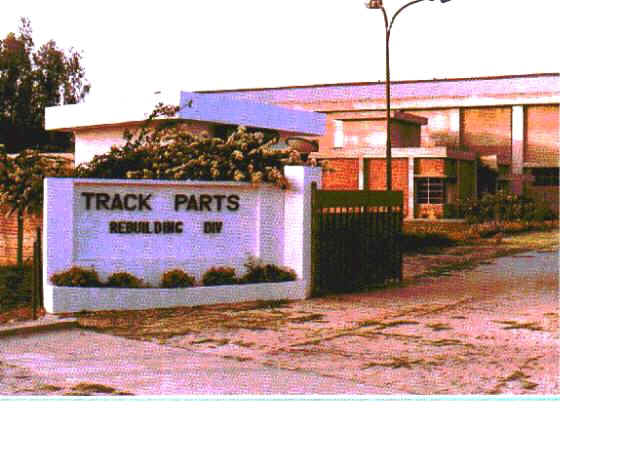
Track Rebuilding Division of Trackparts of India Limited was started in 1988 with the aim of obtaining one additional life at about half the cost. In a chain Links and Grouser shoes are the only components that can be rebuilt. For rebuilding Link we use Mig welding technology while the Lugs of the Grouser Shoe are cut to standard height and welded with new forged Lugs.
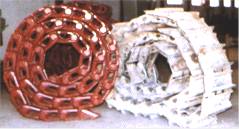
![]()
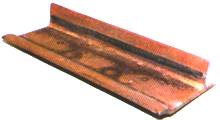 OLD AND RECONDITIONED CHAINS LINK
GROUSER SHOE
OLD AND RECONDITIONED CHAINS LINK
GROUSER SHOE
We manufacture Pins and Bushes at our works in Track Component Division. As you must be well aware that the life of an undercarriage depends mainly on the selection of material and the life to the material is given by the heat treatment done on it.
In bushes carburising process is adopted while in pins Induction hardening is the process used for heat treatment. Both of the processes are very critical processes. Carburising takes nearly 30 hours cycle while Induction hardening take just a few seconds to complete. The hardness patterns are shown in the figs below.
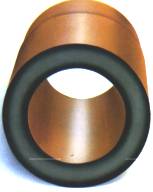
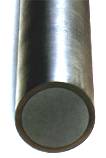
BUSHES PIN
Since the life of the chains is directly related to the wearing on the components, it is very important to know about the wearing reasons of all the components in order to get the maximum life.
The life of an undercarriage depends upon lot of factors some of the important factors are as follows:
“Whoever is born has to die” the same theory applies here i.e. to say that an undercarriage has a life and has to be changed once it is over. The question is what is the life. Since the life of an undercarriage depends on so many factors it becomes impossible to determine life of an undercarriage. What we can talk of is an average life on a particular field/operation. One can say that the undercarriage has given its full life if it has uniform wearing (not damages) allover. Few abnormal wearing patterns and the reasons for the same are given below:
WEARING PATTERN ON
LINKS
 PIN
BOSS WEARING This is
because of the over wearing of links or Rollers. The flange of the roller, which
has more hardness than the link body, causes it. Link height as
well as roller height has to be checked and replaced if needed, otherwise pin
will get loosened and shall come out.
PIN
BOSS WEARING This is
because of the over wearing of links or Rollers. The flange of the roller, which
has more hardness than the link body, causes it. Link height as
well as roller height has to be checked and replaced if needed, otherwise pin
will get loosened and shall come out.
COUNTER BORE ELONGATION This problem can be due to incorrect tooling being used at the time of assembling the chain, or due to the internal wear between pin and bush. This can be eliminated by timely turning of bushes and pins at the right time or by using lubricated chains or by avoiding rough speed variations or can be reduced by fitting smaller shoes and by having correct chain tension.
 UNEVEN
RAIL WEAR At
both the ends it is caused because of greater specific pressure due to the
limited contact surface between rollers and links rail. In the center it is due
to the contact of idler tread with link rail.
UNEVEN
RAIL WEAR At
both the ends it is caused because of greater specific pressure due to the
limited contact surface between rollers and links rail. In the center it is due
to the contact of idler tread with link rail.
RAIL SIDE WEAR This type of wear takes place when the machine works on side hills or the alignment of Idlers, Rollers and Sprockets is out. The chain tension is not proper. Track guides are not fitted. Shoes are too wide or tracks are too snaky. The flange of the roller cuts the sides of the link.
GAUGING OF INTERNAL RAIL SURFACE This is caused by the sprocket teeth rubbing on the inside of the link because of sloping ground or misaligned sprocket and chain or a severely bent track chain.
PIN BOSS WEAR This is caused because of excessive wear of either link surface of roller or both. Rollers and links dimensions should be checked.
![]()
![]()
![]()
BUSH BREAKING BUSH WEARING BUSH END CRACKING
Bush wearing is a natural phenomenon and takes place with time. It wears from the place and side, which is in contact with the sprocket. This indicates the life of the chain. This further results in breaking of the bush. Nothing can be done about it. It order to increase the life of the chain the only possible thing which can be done is to turn the bush to 180 degrees. Now the big question is when? The bush used in a Dozer is hardened to about 60 RC till a depth of 3-6mm depending upon the model, so the turning process should be done at a time when the wearing has taken place to a depth of 2-4 mm.
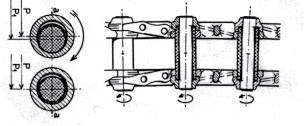
Cracking in bushes is caused by impact with the link counter bore when the pin and bushing clearance and other components wear to allow excessive movement in the joint of the chain. Adjust the chain tension and if possible replace some rollers and, most important, do not exceed the wear limits for the internal dimensions of the pins and bushing.
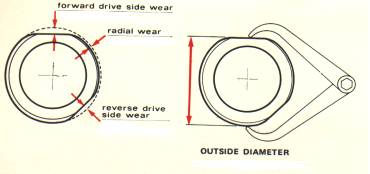
WEAR
PATTERN IN PINS
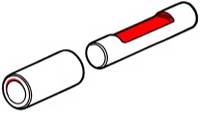 PIN
DIAMETER WEARING This
type of wearing is seen mainly in dry type of chains and not in lubricated
chains. It is due to the friction between the pin and the bush faces. In Dozers
which have long running hours lubricated chains are recommended in order to
avoid this type of wear. This wear can not be seen visually but can be observed
by checking the pitch.
PIN
DIAMETER WEARING This
type of wearing is seen mainly in dry type of chains and not in lubricated
chains. It is due to the friction between the pin and the bush faces. In Dozers
which have long running hours lubricated chains are recommended in order to
avoid this type of wear. This wear can not be seen visually but can be observed
by checking the pitch.
PIN BREAKAGES The main cause of this failure is extreme shock or high static loads which occur when the machine works on rocky ground or when material packs in the sprocket causing extreme tension on the track chain.

PIN EDGES WEAR When the link surface or the roller wears and the roller flange comes in contact with the pin, this leads to this kind of wearing. It can be avoided by changing the rollers or by turning the pins.

LOOSENING OF PINS This can be due to incorrect assembly or disassembly and if there is no obvious fault then this may caused by bending stresses during heavy operation of the tractor.
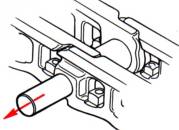
WEARING PATTERN IN GROUSER SHOES
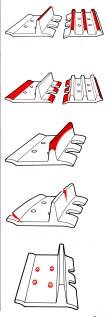 GROUSER
LUG WEAR In grouser
shoes the lug surface is the only surface, which is in real contact with the
ground hence the wearing there, is maximum. To minimize the wearing right type
of shoe should be selected depending upon the type of work and condition.
GROUSER
LUG WEAR In grouser
shoes the lug surface is the only surface, which is in real contact with the
ground hence the wearing there, is maximum. To minimize the wearing right type
of shoe should be selected depending upon the type of work and condition.
ACCELERATED WEAR OF OVERLAPPING SURFACES This is normally caused by a snaking chain and is eliminated by using lubricated chain.
MORE WEAR AT THE END OF THE GROUSER This is especially noticeable on single grousers and usually due to choosing too large a shoe for the type of ground on which the tractor is operating.
BENDING AND CRACKING this is a sign of improper selection of the shoe. Either its capacity is less or uneven loading is being done on it. Use smaller shoes and change to supper ESS type of shoes.
BOLT HOLE OVALITY This is due to relative movement between the chain and shoe due to low bolt torque or machine motion. To eliminate this ovality problem use double or triple rib grousers and tighten the bolt with proper torque. Also check the tension after first 100 hours of working of the new chain and thereafter every 400-500 hrs.

While calculating the pitch of a chain it should be kept in mind that at least
3-4 sections should be measured at a time and then the total length from the
center of one pin to the fourth should be divided by four.
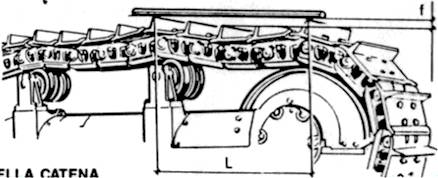
To measure track sag roll machine to stop from forward
operation on level ground. Place a straight bar as shown in the fig. The grouser
shoes should be of equal height. The tension is correct when
F
= from l/50 to l/35 for excavators
And
F
= from l/35 to l/25 for dozers
Information By Sameer Bhargava